Analyzing Australia's Healthcare System and Foreign-Born Workers
VerifiedAdded on 2023/01/10
|13
|2412
|30
Report
AI Summary
This report delves into Australia's healthcare system, analyzing its growing dependence on foreign-born healthcare service providers. It examines the context of an aging population and workforce shortages. The report assesses the current Australian government policies on international worker immigration, considering their sustainability and the historical reasons behind their development. It also explores the recommendations of the World Health Organization (WHO) regarding the recognition of healthcare worker qualifications. Furthermore, the report discusses the challenges of workforce migration, cultural clashes, and discrimination faced by foreign-born healthcare workers. The report concludes by suggesting necessary policy changes to ensure a more sustainable and equitable healthcare system, emphasizing the need for improved recognition and support for these essential workers to meet the increasing healthcare demands of Australia.
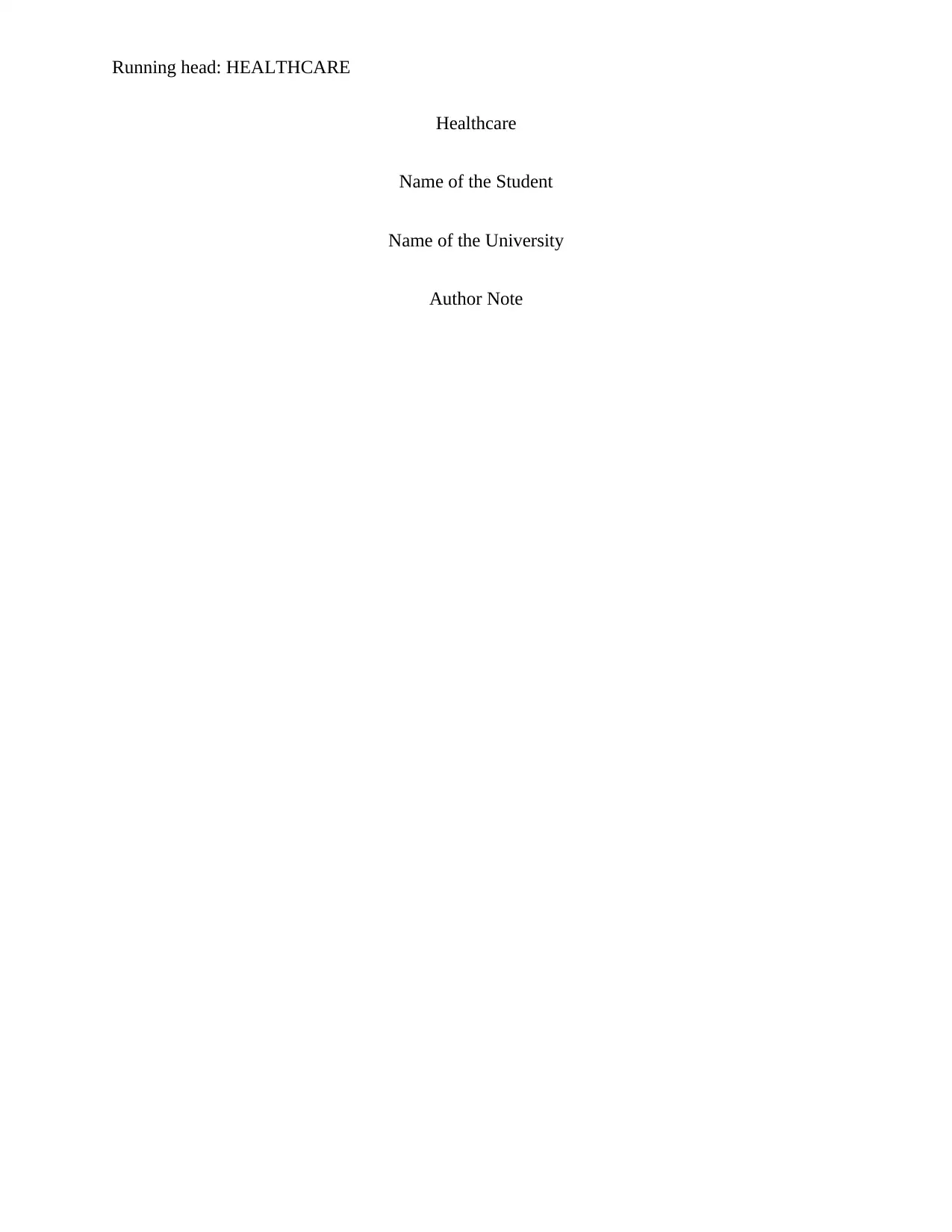
Running head: HEALTHCARE
Healthcare
Name of the Student
Name of the University
Author Note
Healthcare
Name of the Student
Name of the University
Author Note
Paraphrase This Document
Need a fresh take? Get an instant paraphrase of this document with our AI Paraphraser
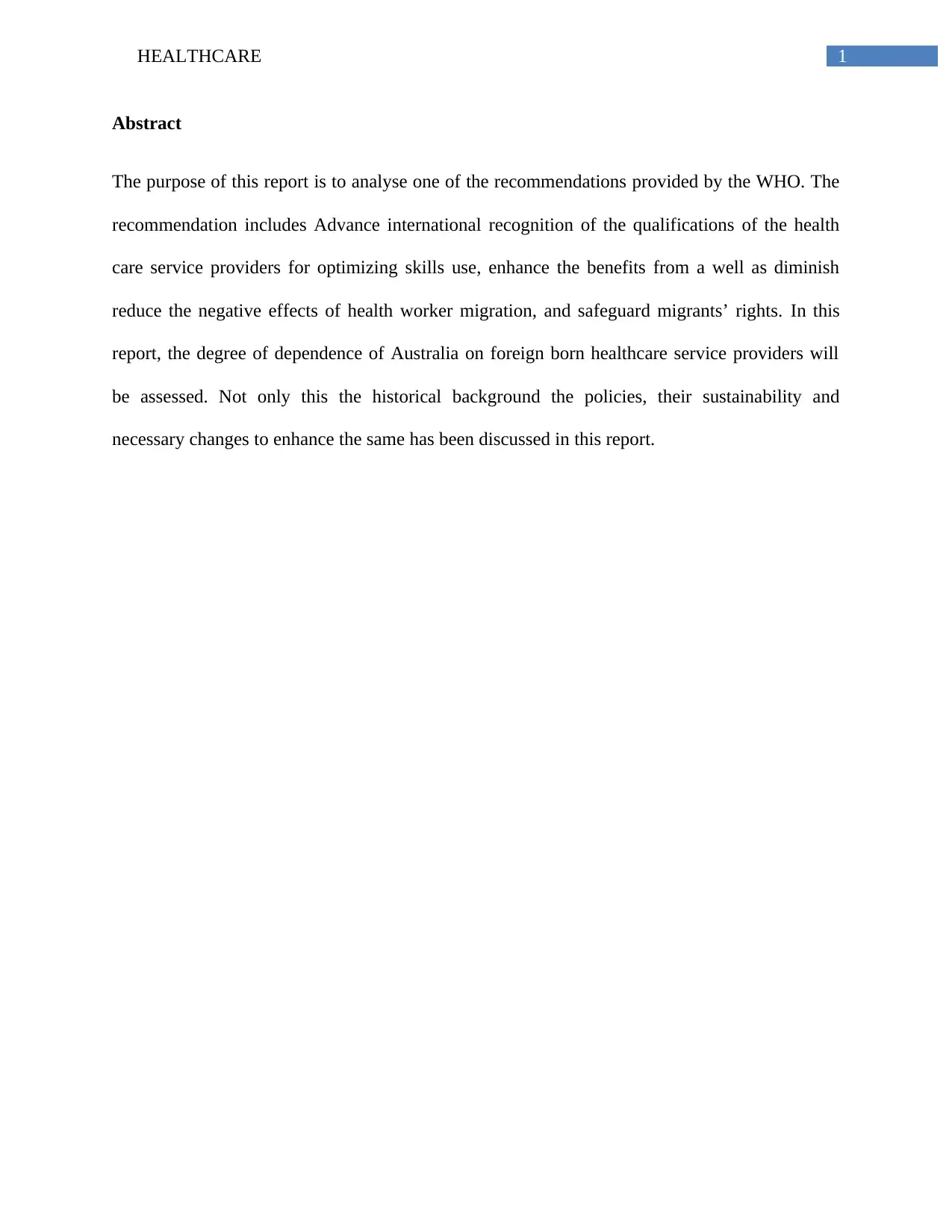
1HEALTHCARE
Abstract
The purpose of this report is to analyse one of the recommendations provided by the WHO. The
recommendation includes Advance international recognition of the qualifications of the health
care service providers for optimizing skills use, enhance the benefits from a well as diminish
reduce the negative effects of health worker migration, and safeguard migrants’ rights. In this
report, the degree of dependence of Australia on foreign born healthcare service providers will
be assessed. Not only this the historical background the policies, their sustainability and
necessary changes to enhance the same has been discussed in this report.
Abstract
The purpose of this report is to analyse one of the recommendations provided by the WHO. The
recommendation includes Advance international recognition of the qualifications of the health
care service providers for optimizing skills use, enhance the benefits from a well as diminish
reduce the negative effects of health worker migration, and safeguard migrants’ rights. In this
report, the degree of dependence of Australia on foreign born healthcare service providers will
be assessed. Not only this the historical background the policies, their sustainability and
necessary changes to enhance the same has been discussed in this report.
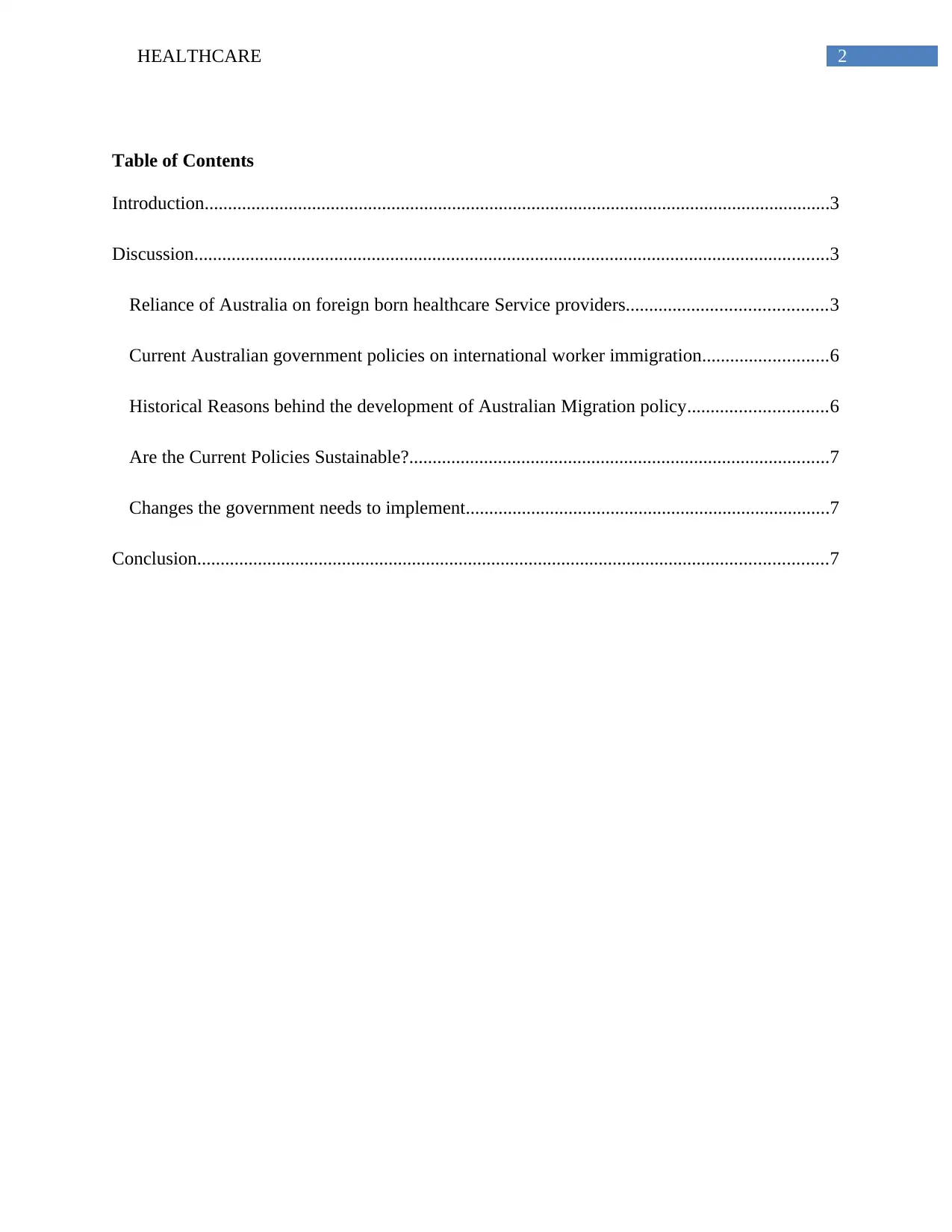
2HEALTHCARE
Table of Contents
Introduction......................................................................................................................................3
Discussion........................................................................................................................................3
Reliance of Australia on foreign born healthcare Service providers...........................................3
Current Australian government policies on international worker immigration...........................6
Historical Reasons behind the development of Australian Migration policy..............................6
Are the Current Policies Sustainable?..........................................................................................7
Changes the government needs to implement..............................................................................7
Conclusion.......................................................................................................................................7
Table of Contents
Introduction......................................................................................................................................3
Discussion........................................................................................................................................3
Reliance of Australia on foreign born healthcare Service providers...........................................3
Current Australian government policies on international worker immigration...........................6
Historical Reasons behind the development of Australian Migration policy..............................6
Are the Current Policies Sustainable?..........................................................................................7
Changes the government needs to implement..............................................................................7
Conclusion.......................................................................................................................................7
⊘ This is a preview!⊘
Do you want full access?
Subscribe today to unlock all pages.

Trusted by 1+ million students worldwide
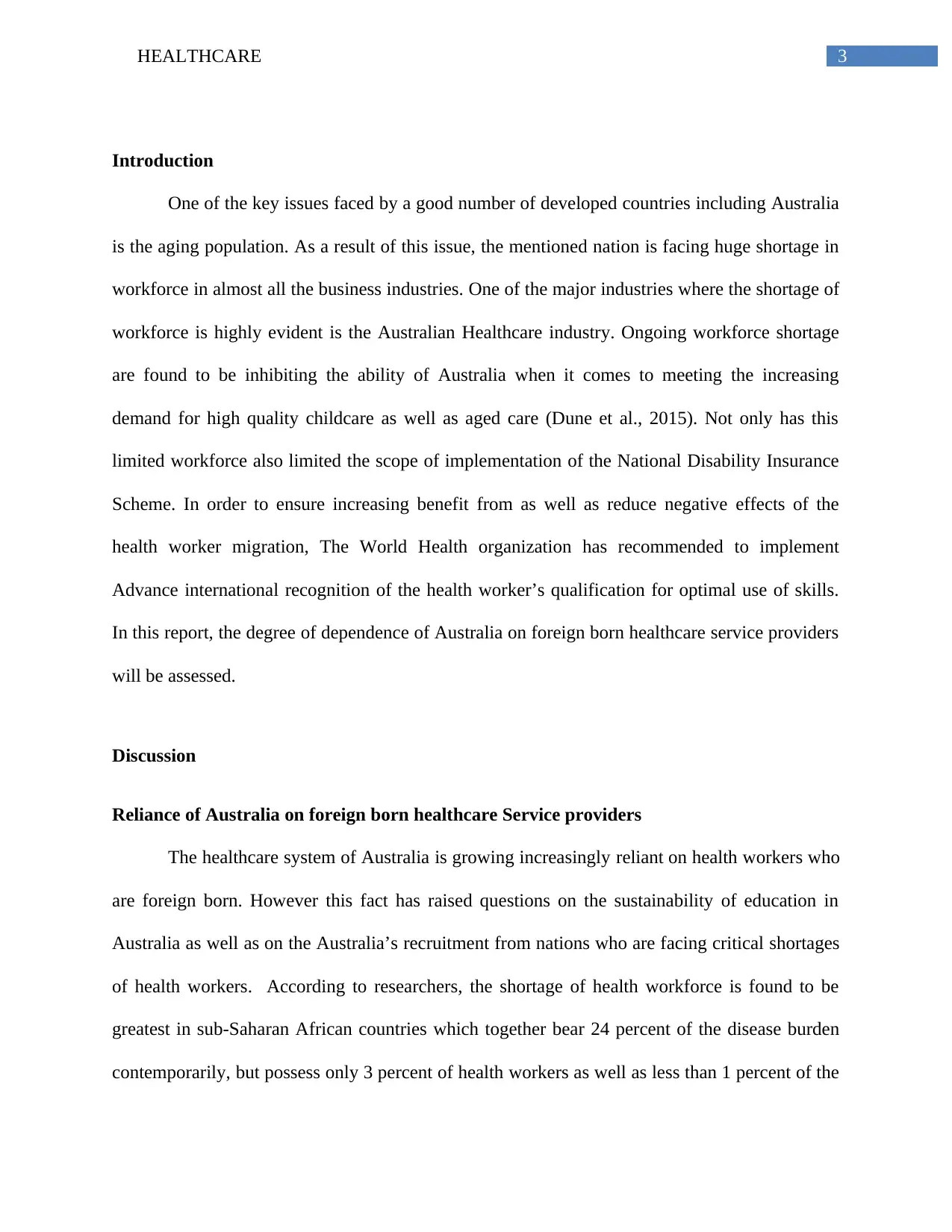
3HEALTHCARE
Introduction
One of the key issues faced by a good number of developed countries including Australia
is the aging population. As a result of this issue, the mentioned nation is facing huge shortage in
workforce in almost all the business industries. One of the major industries where the shortage of
workforce is highly evident is the Australian Healthcare industry. Ongoing workforce shortage
are found to be inhibiting the ability of Australia when it comes to meeting the increasing
demand for high quality childcare as well as aged care (Dune et al., 2015). Not only has this
limited workforce also limited the scope of implementation of the National Disability Insurance
Scheme. In order to ensure increasing benefit from as well as reduce negative effects of the
health worker migration, The World Health organization has recommended to implement
Advance international recognition of the health worker’s qualification for optimal use of skills.
In this report, the degree of dependence of Australia on foreign born healthcare service providers
will be assessed.
Discussion
Reliance of Australia on foreign born healthcare Service providers
The healthcare system of Australia is growing increasingly reliant on health workers who
are foreign born. However this fact has raised questions on the sustainability of education in
Australia as well as on the Australia’s recruitment from nations who are facing critical shortages
of health workers. According to researchers, the shortage of health workforce is found to be
greatest in sub-Saharan African countries which together bear 24 percent of the disease burden
contemporarily, but possess only 3 percent of health workers as well as less than 1 percent of the
Introduction
One of the key issues faced by a good number of developed countries including Australia
is the aging population. As a result of this issue, the mentioned nation is facing huge shortage in
workforce in almost all the business industries. One of the major industries where the shortage of
workforce is highly evident is the Australian Healthcare industry. Ongoing workforce shortage
are found to be inhibiting the ability of Australia when it comes to meeting the increasing
demand for high quality childcare as well as aged care (Dune et al., 2015). Not only has this
limited workforce also limited the scope of implementation of the National Disability Insurance
Scheme. In order to ensure increasing benefit from as well as reduce negative effects of the
health worker migration, The World Health organization has recommended to implement
Advance international recognition of the health worker’s qualification for optimal use of skills.
In this report, the degree of dependence of Australia on foreign born healthcare service providers
will be assessed.
Discussion
Reliance of Australia on foreign born healthcare Service providers
The healthcare system of Australia is growing increasingly reliant on health workers who
are foreign born. However this fact has raised questions on the sustainability of education in
Australia as well as on the Australia’s recruitment from nations who are facing critical shortages
of health workers. According to researchers, the shortage of health workforce is found to be
greatest in sub-Saharan African countries which together bear 24 percent of the disease burden
contemporarily, but possess only 3 percent of health workers as well as less than 1 percent of the
Paraphrase This Document
Need a fresh take? Get an instant paraphrase of this document with our AI Paraphraser
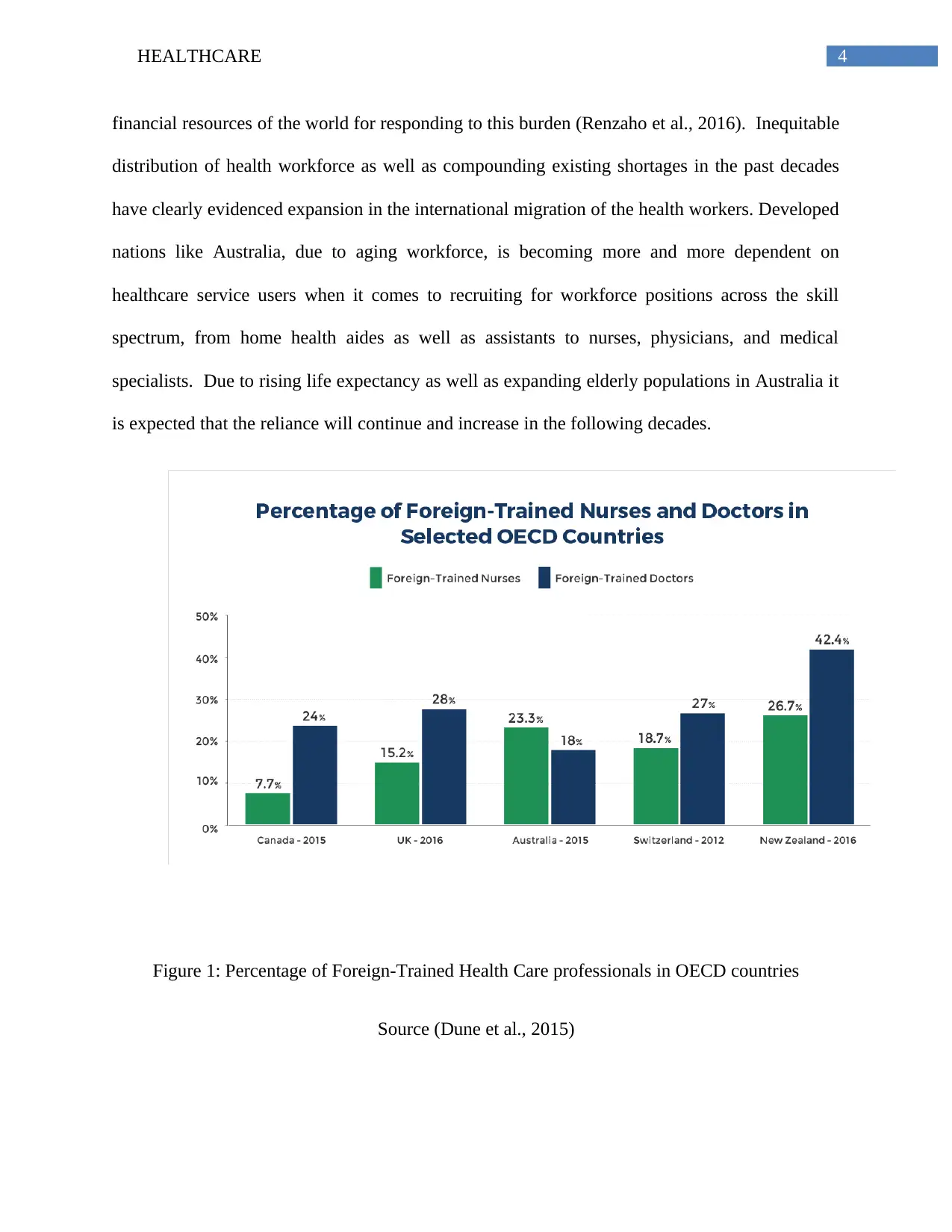
4HEALTHCARE
financial resources of the world for responding to this burden (Renzaho et al., 2016). Inequitable
distribution of health workforce as well as compounding existing shortages in the past decades
have clearly evidenced expansion in the international migration of the health workers. Developed
nations like Australia, due to aging workforce, is becoming more and more dependent on
healthcare service users when it comes to recruiting for workforce positions across the skill
spectrum, from home health aides as well as assistants to nurses, physicians, and medical
specialists. Due to rising life expectancy as well as expanding elderly populations in Australia it
is expected that the reliance will continue and increase in the following decades.
Figure 1: Percentage of Foreign-Trained Health Care professionals in OECD countries
Source (Dune et al., 2015)
financial resources of the world for responding to this burden (Renzaho et al., 2016). Inequitable
distribution of health workforce as well as compounding existing shortages in the past decades
have clearly evidenced expansion in the international migration of the health workers. Developed
nations like Australia, due to aging workforce, is becoming more and more dependent on
healthcare service users when it comes to recruiting for workforce positions across the skill
spectrum, from home health aides as well as assistants to nurses, physicians, and medical
specialists. Due to rising life expectancy as well as expanding elderly populations in Australia it
is expected that the reliance will continue and increase in the following decades.
Figure 1: Percentage of Foreign-Trained Health Care professionals in OECD countries
Source (Dune et al., 2015)
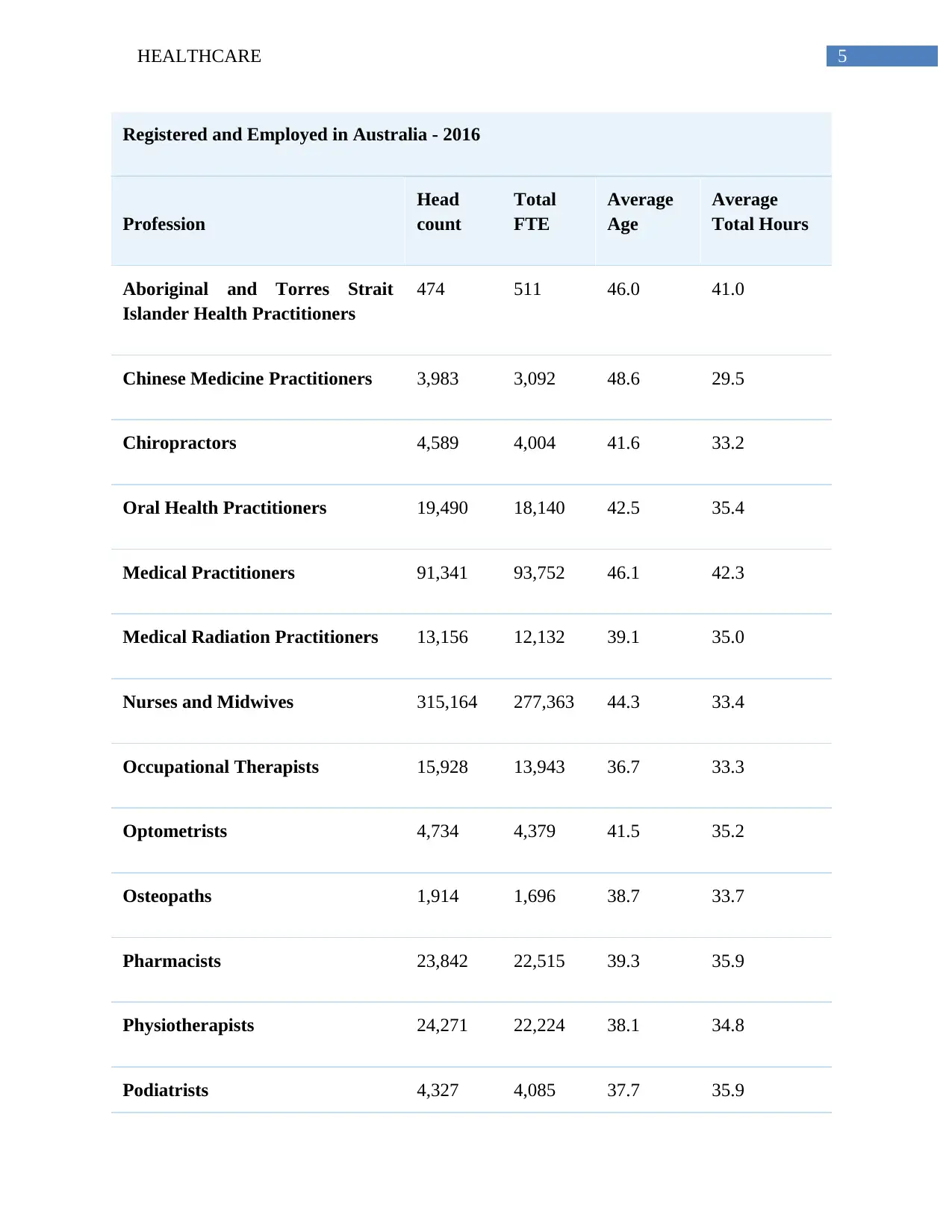
5HEALTHCARE
Registered and Employed in Australia - 2016
Profession
Head
count
Total
FTE
Average
Age
Average
Total Hours
Aboriginal and Torres Strait
Islander Health Practitioners
474 511 46.0 41.0
Chinese Medicine Practitioners 3,983 3,092 48.6 29.5
Chiropractors 4,589 4,004 41.6 33.2
Oral Health Practitioners 19,490 18,140 42.5 35.4
Medical Practitioners 91,341 93,752 46.1 42.3
Medical Radiation Practitioners 13,156 12,132 39.1 35.0
Nurses and Midwives 315,164 277,363 44.3 33.4
Occupational Therapists 15,928 13,943 36.7 33.3
Optometrists 4,734 4,379 41.5 35.2
Osteopaths 1,914 1,696 38.7 33.7
Pharmacists 23,842 22,515 39.3 35.9
Physiotherapists 24,271 22,224 38.1 34.8
Podiatrists 4,327 4,085 37.7 35.9
Registered and Employed in Australia - 2016
Profession
Head
count
Total
FTE
Average
Age
Average
Total Hours
Aboriginal and Torres Strait
Islander Health Practitioners
474 511 46.0 41.0
Chinese Medicine Practitioners 3,983 3,092 48.6 29.5
Chiropractors 4,589 4,004 41.6 33.2
Oral Health Practitioners 19,490 18,140 42.5 35.4
Medical Practitioners 91,341 93,752 46.1 42.3
Medical Radiation Practitioners 13,156 12,132 39.1 35.0
Nurses and Midwives 315,164 277,363 44.3 33.4
Occupational Therapists 15,928 13,943 36.7 33.3
Optometrists 4,734 4,379 41.5 35.2
Osteopaths 1,914 1,696 38.7 33.7
Pharmacists 23,842 22,515 39.3 35.9
Physiotherapists 24,271 22,224 38.1 34.8
Podiatrists 4,327 4,085 37.7 35.9
⊘ This is a preview!⊘
Do you want full access?
Subscribe today to unlock all pages.

Trusted by 1+ million students worldwide
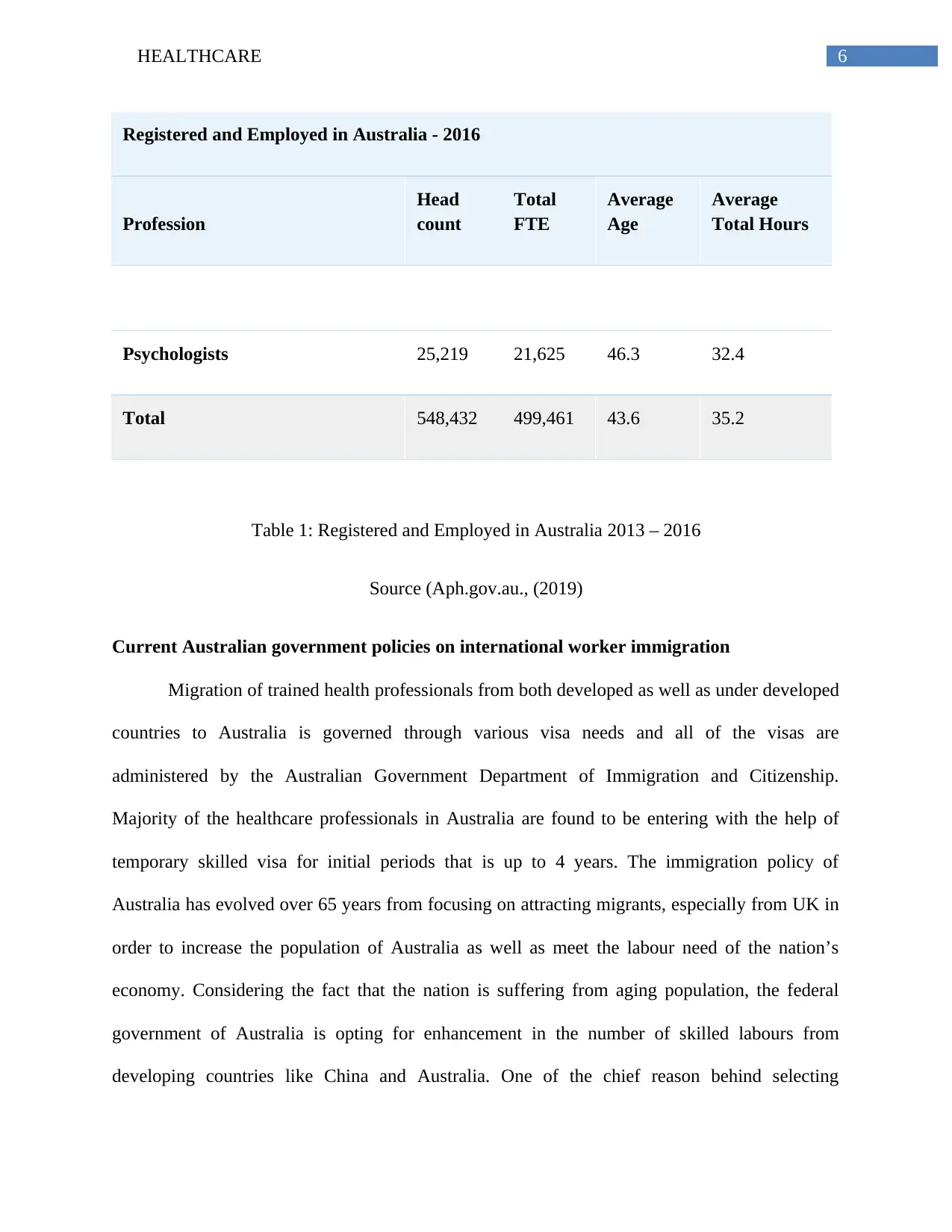
6HEALTHCARE
Registered and Employed in Australia - 2016
Profession
Head
count
Total
FTE
Average
Age
Average
Total Hours
Psychologists 25,219 21,625 46.3 32.4
Total 548,432 499,461 43.6 35.2
Table 1: Registered and Employed in Australia 2013 – 2016
Source (Aph.gov.au., (2019)
Current Australian government policies on international worker immigration
Migration of trained health professionals from both developed as well as under developed
countries to Australia is governed through various visa needs and all of the visas are
administered by the Australian Government Department of Immigration and Citizenship.
Majority of the healthcare professionals in Australia are found to be entering with the help of
temporary skilled visa for initial periods that is up to 4 years. The immigration policy of
Australia has evolved over 65 years from focusing on attracting migrants, especially from UK in
order to increase the population of Australia as well as meet the labour need of the nation’s
economy. Considering the fact that the nation is suffering from aging population, the federal
government of Australia is opting for enhancement in the number of skilled labours from
developing countries like China and Australia. One of the chief reason behind selecting
Registered and Employed in Australia - 2016
Profession
Head
count
Total
FTE
Average
Age
Average
Total Hours
Psychologists 25,219 21,625 46.3 32.4
Total 548,432 499,461 43.6 35.2
Table 1: Registered and Employed in Australia 2013 – 2016
Source (Aph.gov.au., (2019)
Current Australian government policies on international worker immigration
Migration of trained health professionals from both developed as well as under developed
countries to Australia is governed through various visa needs and all of the visas are
administered by the Australian Government Department of Immigration and Citizenship.
Majority of the healthcare professionals in Australia are found to be entering with the help of
temporary skilled visa for initial periods that is up to 4 years. The immigration policy of
Australia has evolved over 65 years from focusing on attracting migrants, especially from UK in
order to increase the population of Australia as well as meet the labour need of the nation’s
economy. Considering the fact that the nation is suffering from aging population, the federal
government of Australia is opting for enhancement in the number of skilled labours from
developing countries like China and Australia. One of the chief reason behind selecting
Paraphrase This Document
Need a fresh take? Get an instant paraphrase of this document with our AI Paraphraser
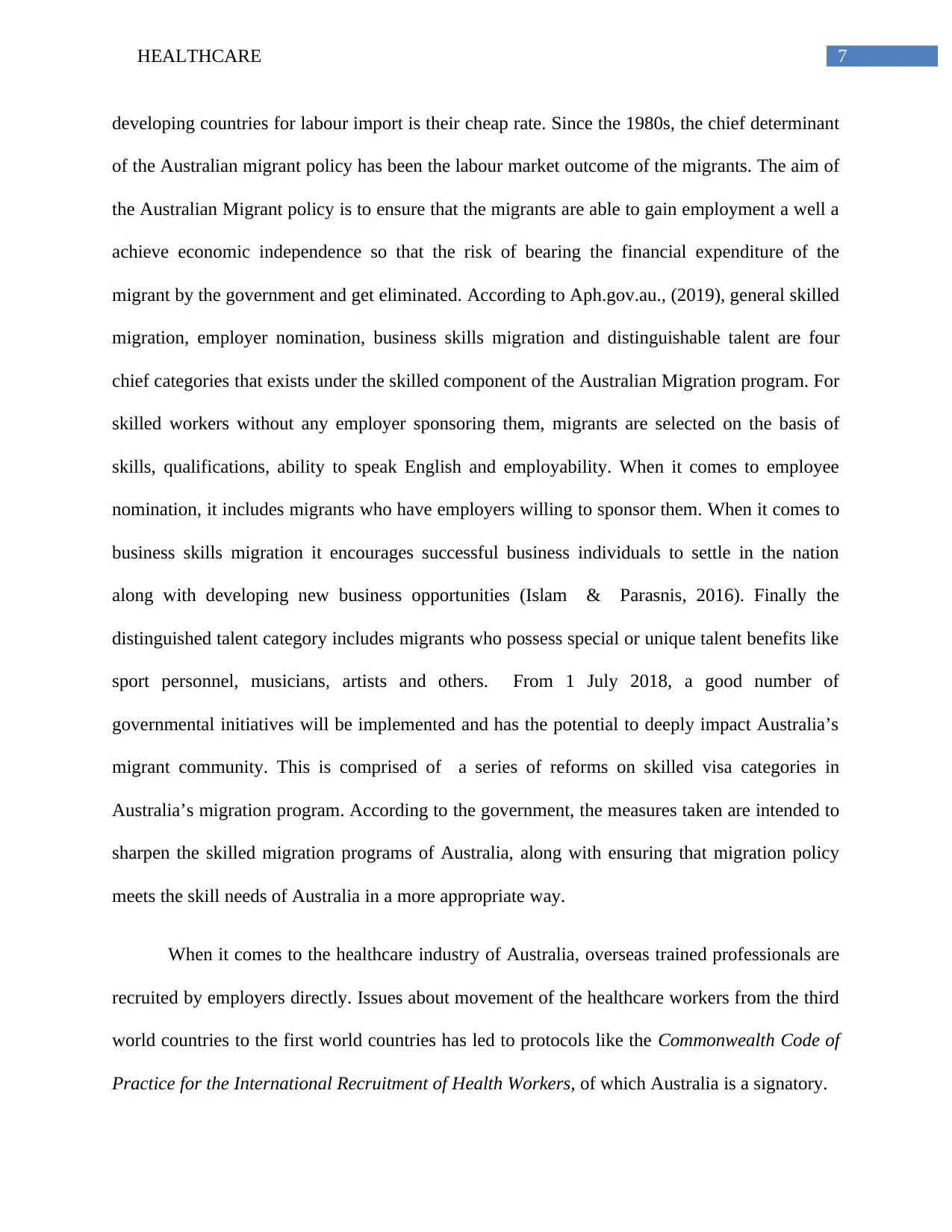
7HEALTHCARE
developing countries for labour import is their cheap rate. Since the 1980s, the chief determinant
of the Australian migrant policy has been the labour market outcome of the migrants. The aim of
the Australian Migrant policy is to ensure that the migrants are able to gain employment a well a
achieve economic independence so that the risk of bearing the financial expenditure of the
migrant by the government and get eliminated. According to Aph.gov.au., (2019), general skilled
migration, employer nomination, business skills migration and distinguishable talent are four
chief categories that exists under the skilled component of the Australian Migration program. For
skilled workers without any employer sponsoring them, migrants are selected on the basis of
skills, qualifications, ability to speak English and employability. When it comes to employee
nomination, it includes migrants who have employers willing to sponsor them. When it comes to
business skills migration it encourages successful business individuals to settle in the nation
along with developing new business opportunities (Islam & Parasnis, 2016). Finally the
distinguished talent category includes migrants who possess special or unique talent benefits like
sport personnel, musicians, artists and others. From 1 July 2018, a good number of
governmental initiatives will be implemented and has the potential to deeply impact Australia’s
migrant community. This is comprised of a series of reforms on skilled visa categories in
Australia’s migration program. According to the government, the measures taken are intended to
sharpen the skilled migration programs of Australia, along with ensuring that migration policy
meets the skill needs of Australia in a more appropriate way.
When it comes to the healthcare industry of Australia, overseas trained professionals are
recruited by employers directly. Issues about movement of the healthcare workers from the third
world countries to the first world countries has led to protocols like the Commonwealth Code of
Practice for the International Recruitment of Health Workers, of which Australia is a signatory.
developing countries for labour import is their cheap rate. Since the 1980s, the chief determinant
of the Australian migrant policy has been the labour market outcome of the migrants. The aim of
the Australian Migrant policy is to ensure that the migrants are able to gain employment a well a
achieve economic independence so that the risk of bearing the financial expenditure of the
migrant by the government and get eliminated. According to Aph.gov.au., (2019), general skilled
migration, employer nomination, business skills migration and distinguishable talent are four
chief categories that exists under the skilled component of the Australian Migration program. For
skilled workers without any employer sponsoring them, migrants are selected on the basis of
skills, qualifications, ability to speak English and employability. When it comes to employee
nomination, it includes migrants who have employers willing to sponsor them. When it comes to
business skills migration it encourages successful business individuals to settle in the nation
along with developing new business opportunities (Islam & Parasnis, 2016). Finally the
distinguished talent category includes migrants who possess special or unique talent benefits like
sport personnel, musicians, artists and others. From 1 July 2018, a good number of
governmental initiatives will be implemented and has the potential to deeply impact Australia’s
migrant community. This is comprised of a series of reforms on skilled visa categories in
Australia’s migration program. According to the government, the measures taken are intended to
sharpen the skilled migration programs of Australia, along with ensuring that migration policy
meets the skill needs of Australia in a more appropriate way.
When it comes to the healthcare industry of Australia, overseas trained professionals are
recruited by employers directly. Issues about movement of the healthcare workers from the third
world countries to the first world countries has led to protocols like the Commonwealth Code of
Practice for the International Recruitment of Health Workers, of which Australia is a signatory.
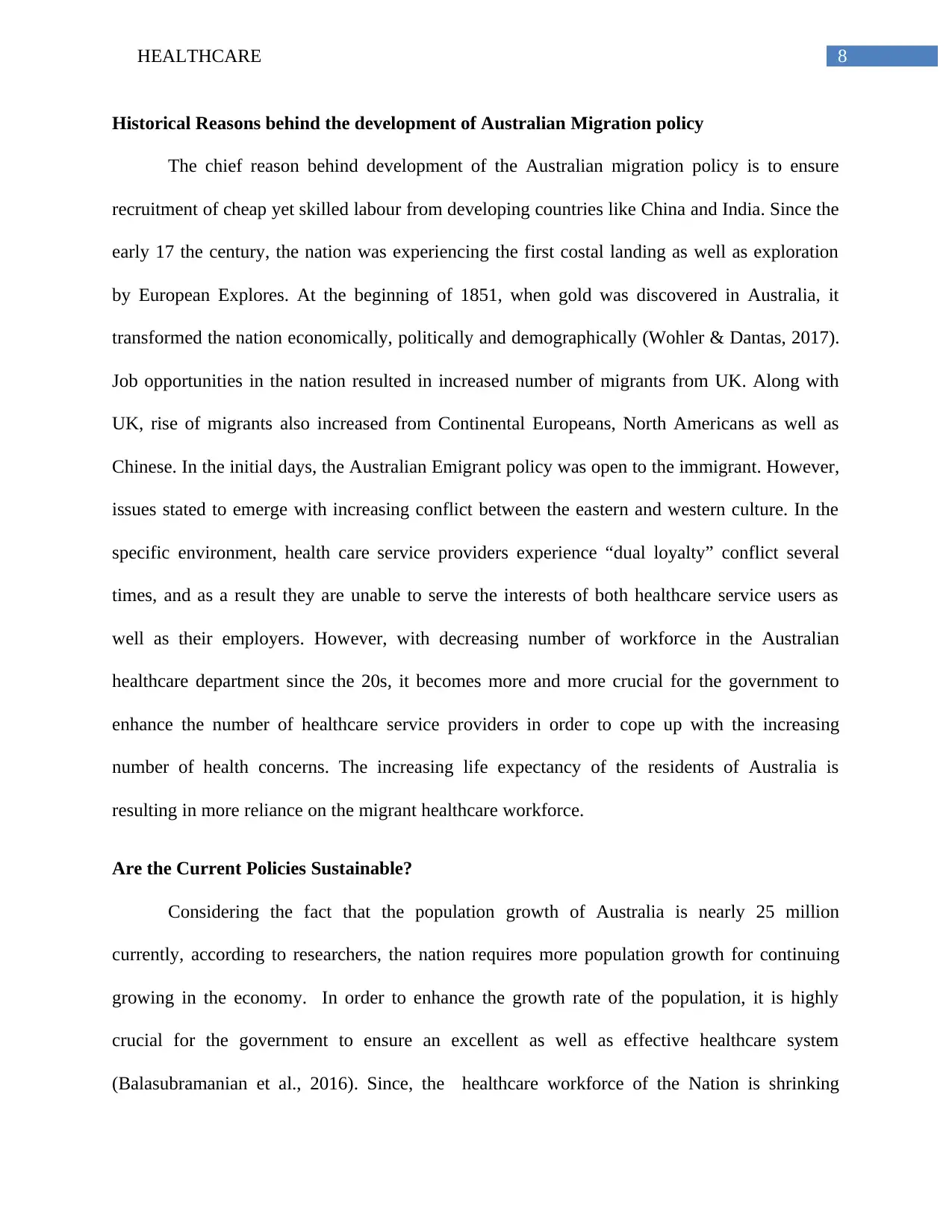
8HEALTHCARE
Historical Reasons behind the development of Australian Migration policy
The chief reason behind development of the Australian migration policy is to ensure
recruitment of cheap yet skilled labour from developing countries like China and India. Since the
early 17 the century, the nation was experiencing the first costal landing as well as exploration
by European Explores. At the beginning of 1851, when gold was discovered in Australia, it
transformed the nation economically, politically and demographically (Wohler & Dantas, 2017).
Job opportunities in the nation resulted in increased number of migrants from UK. Along with
UK, rise of migrants also increased from Continental Europeans, North Americans as well as
Chinese. In the initial days, the Australian Emigrant policy was open to the immigrant. However,
issues stated to emerge with increasing conflict between the eastern and western culture. In the
specific environment, health care service providers experience “dual loyalty” conflict several
times, and as a result they are unable to serve the interests of both healthcare service users as
well as their employers. However, with decreasing number of workforce in the Australian
healthcare department since the 20s, it becomes more and more crucial for the government to
enhance the number of healthcare service providers in order to cope up with the increasing
number of health concerns. The increasing life expectancy of the residents of Australia is
resulting in more reliance on the migrant healthcare workforce.
Are the Current Policies Sustainable?
Considering the fact that the population growth of Australia is nearly 25 million
currently, according to researchers, the nation requires more population growth for continuing
growing in the economy. In order to enhance the growth rate of the population, it is highly
crucial for the government to ensure an excellent as well as effective healthcare system
(Balasubramanian et al., 2016). Since, the healthcare workforce of the Nation is shrinking
Historical Reasons behind the development of Australian Migration policy
The chief reason behind development of the Australian migration policy is to ensure
recruitment of cheap yet skilled labour from developing countries like China and India. Since the
early 17 the century, the nation was experiencing the first costal landing as well as exploration
by European Explores. At the beginning of 1851, when gold was discovered in Australia, it
transformed the nation economically, politically and demographically (Wohler & Dantas, 2017).
Job opportunities in the nation resulted in increased number of migrants from UK. Along with
UK, rise of migrants also increased from Continental Europeans, North Americans as well as
Chinese. In the initial days, the Australian Emigrant policy was open to the immigrant. However,
issues stated to emerge with increasing conflict between the eastern and western culture. In the
specific environment, health care service providers experience “dual loyalty” conflict several
times, and as a result they are unable to serve the interests of both healthcare service users as
well as their employers. However, with decreasing number of workforce in the Australian
healthcare department since the 20s, it becomes more and more crucial for the government to
enhance the number of healthcare service providers in order to cope up with the increasing
number of health concerns. The increasing life expectancy of the residents of Australia is
resulting in more reliance on the migrant healthcare workforce.
Are the Current Policies Sustainable?
Considering the fact that the population growth of Australia is nearly 25 million
currently, according to researchers, the nation requires more population growth for continuing
growing in the economy. In order to enhance the growth rate of the population, it is highly
crucial for the government to ensure an excellent as well as effective healthcare system
(Balasubramanian et al., 2016). Since, the healthcare workforce of the Nation is shrinking
⊘ This is a preview!⊘
Do you want full access?
Subscribe today to unlock all pages.

Trusted by 1+ million students worldwide
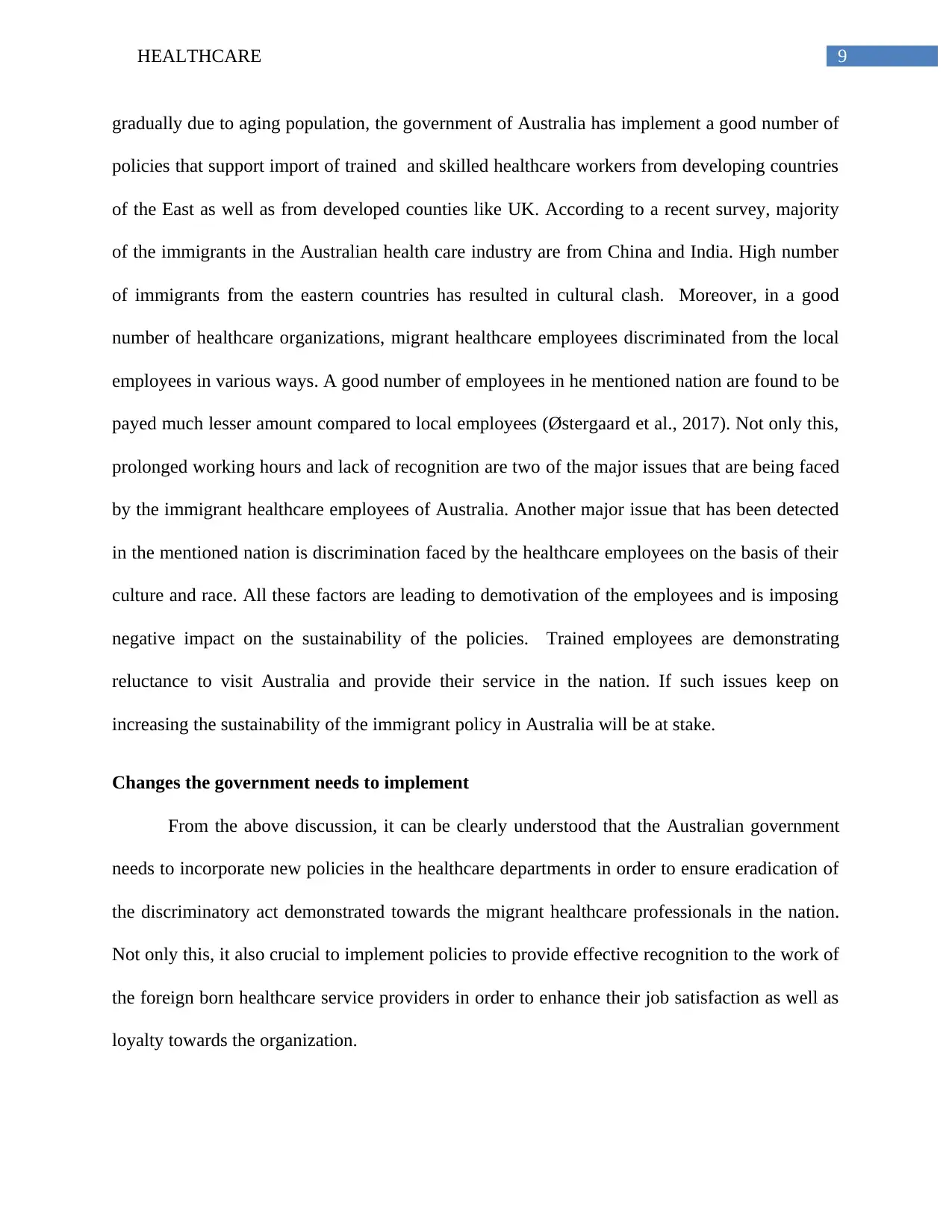
9HEALTHCARE
gradually due to aging population, the government of Australia has implement a good number of
policies that support import of trained and skilled healthcare workers from developing countries
of the East as well as from developed counties like UK. According to a recent survey, majority
of the immigrants in the Australian health care industry are from China and India. High number
of immigrants from the eastern countries has resulted in cultural clash. Moreover, in a good
number of healthcare organizations, migrant healthcare employees discriminated from the local
employees in various ways. A good number of employees in he mentioned nation are found to be
payed much lesser amount compared to local employees (Østergaard et al., 2017). Not only this,
prolonged working hours and lack of recognition are two of the major issues that are being faced
by the immigrant healthcare employees of Australia. Another major issue that has been detected
in the mentioned nation is discrimination faced by the healthcare employees on the basis of their
culture and race. All these factors are leading to demotivation of the employees and is imposing
negative impact on the sustainability of the policies. Trained employees are demonstrating
reluctance to visit Australia and provide their service in the nation. If such issues keep on
increasing the sustainability of the immigrant policy in Australia will be at stake.
Changes the government needs to implement
From the above discussion, it can be clearly understood that the Australian government
needs to incorporate new policies in the healthcare departments in order to ensure eradication of
the discriminatory act demonstrated towards the migrant healthcare professionals in the nation.
Not only this, it also crucial to implement policies to provide effective recognition to the work of
the foreign born healthcare service providers in order to enhance their job satisfaction as well as
loyalty towards the organization.
gradually due to aging population, the government of Australia has implement a good number of
policies that support import of trained and skilled healthcare workers from developing countries
of the East as well as from developed counties like UK. According to a recent survey, majority
of the immigrants in the Australian health care industry are from China and India. High number
of immigrants from the eastern countries has resulted in cultural clash. Moreover, in a good
number of healthcare organizations, migrant healthcare employees discriminated from the local
employees in various ways. A good number of employees in he mentioned nation are found to be
payed much lesser amount compared to local employees (Østergaard et al., 2017). Not only this,
prolonged working hours and lack of recognition are two of the major issues that are being faced
by the immigrant healthcare employees of Australia. Another major issue that has been detected
in the mentioned nation is discrimination faced by the healthcare employees on the basis of their
culture and race. All these factors are leading to demotivation of the employees and is imposing
negative impact on the sustainability of the policies. Trained employees are demonstrating
reluctance to visit Australia and provide their service in the nation. If such issues keep on
increasing the sustainability of the immigrant policy in Australia will be at stake.
Changes the government needs to implement
From the above discussion, it can be clearly understood that the Australian government
needs to incorporate new policies in the healthcare departments in order to ensure eradication of
the discriminatory act demonstrated towards the migrant healthcare professionals in the nation.
Not only this, it also crucial to implement policies to provide effective recognition to the work of
the foreign born healthcare service providers in order to enhance their job satisfaction as well as
loyalty towards the organization.
Paraphrase This Document
Need a fresh take? Get an instant paraphrase of this document with our AI Paraphraser
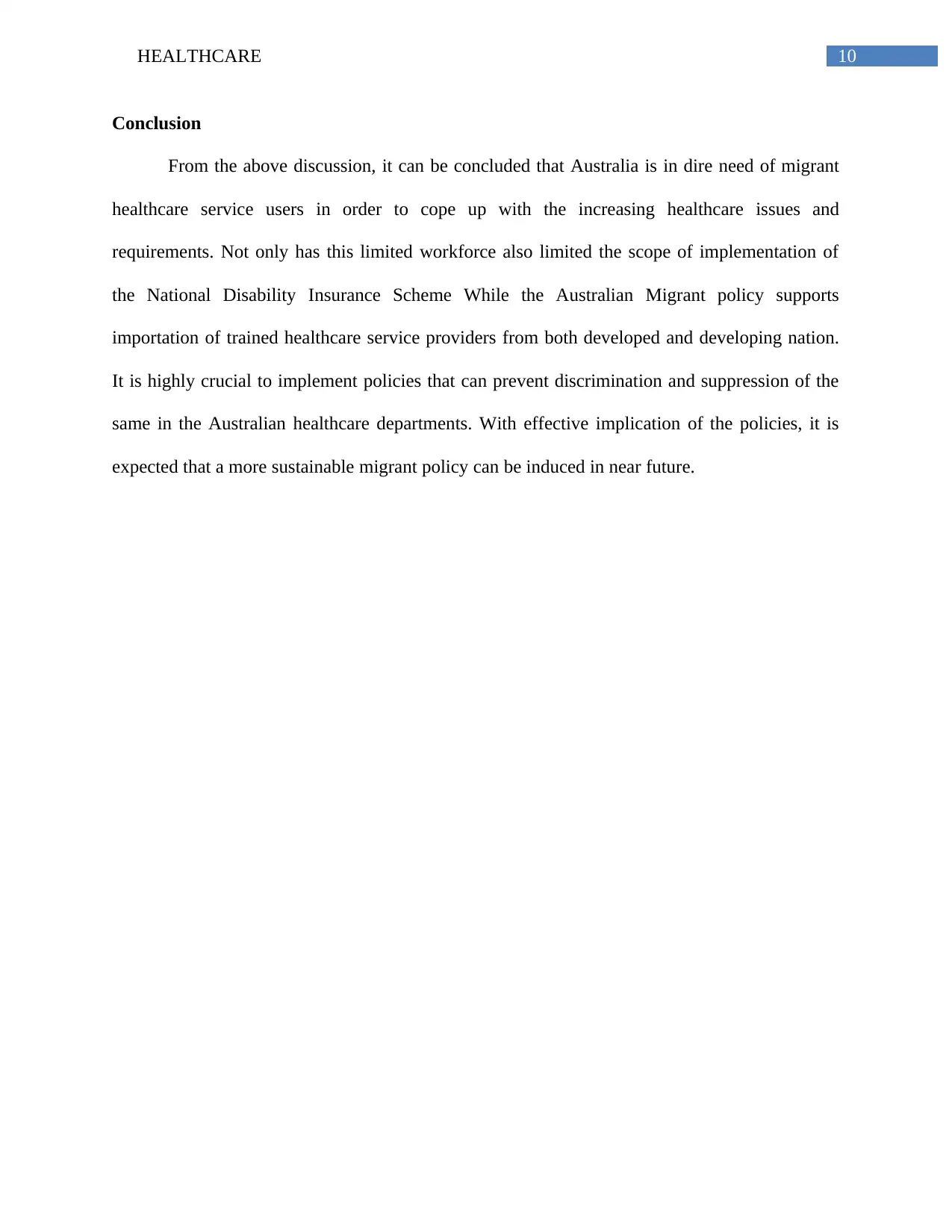
10HEALTHCARE
Conclusion
From the above discussion, it can be concluded that Australia is in dire need of migrant
healthcare service users in order to cope up with the increasing healthcare issues and
requirements. Not only has this limited workforce also limited the scope of implementation of
the National Disability Insurance Scheme While the Australian Migrant policy supports
importation of trained healthcare service providers from both developed and developing nation.
It is highly crucial to implement policies that can prevent discrimination and suppression of the
same in the Australian healthcare departments. With effective implication of the policies, it is
expected that a more sustainable migrant policy can be induced in near future.
Conclusion
From the above discussion, it can be concluded that Australia is in dire need of migrant
healthcare service users in order to cope up with the increasing healthcare issues and
requirements. Not only has this limited workforce also limited the scope of implementation of
the National Disability Insurance Scheme While the Australian Migrant policy supports
importation of trained healthcare service providers from both developed and developing nation.
It is highly crucial to implement policies that can prevent discrimination and suppression of the
same in the Australian healthcare departments. With effective implication of the policies, it is
expected that a more sustainable migrant policy can be induced in near future.
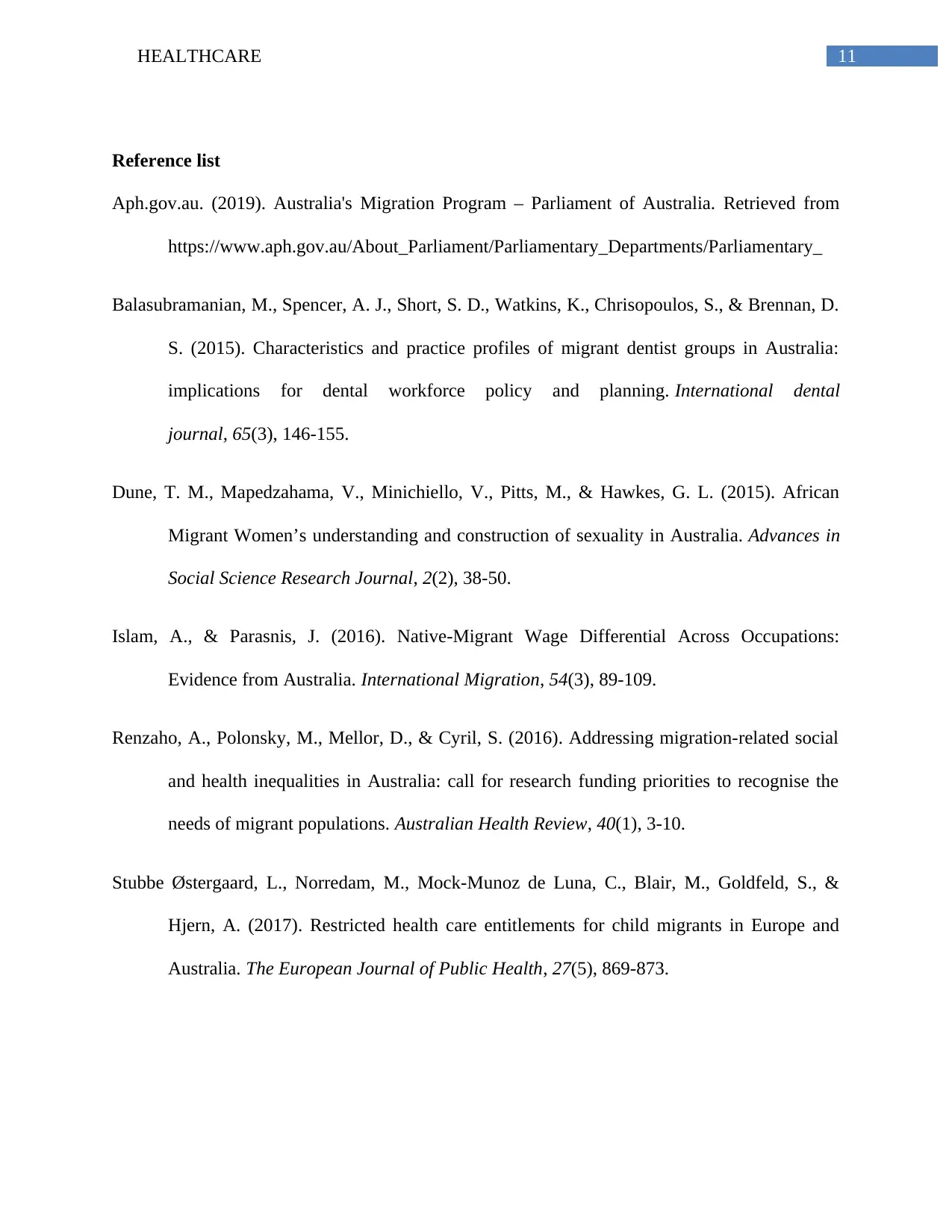
11HEALTHCARE
Reference list
Aph.gov.au. (2019). Australia's Migration Program – Parliament of Australia. Retrieved from
https://www.aph.gov.au/About_Parliament/Parliamentary_Departments/Parliamentary_
Balasubramanian, M., Spencer, A. J., Short, S. D., Watkins, K., Chrisopoulos, S., & Brennan, D.
S. (2015). Characteristics and practice profiles of migrant dentist groups in Australia:
implications for dental workforce policy and planning. International dental
journal, 65(3), 146-155.
Dune, T. M., Mapedzahama, V., Minichiello, V., Pitts, M., & Hawkes, G. L. (2015). African
Migrant Women’s understanding and construction of sexuality in Australia. Advances in
Social Science Research Journal, 2(2), 38-50.
Islam, A., & Parasnis, J. (2016). Native‐Migrant Wage Differential Across Occupations:
Evidence from Australia. International Migration, 54(3), 89-109.
Renzaho, A., Polonsky, M., Mellor, D., & Cyril, S. (2016). Addressing migration-related social
and health inequalities in Australia: call for research funding priorities to recognise the
needs of migrant populations. Australian Health Review, 40(1), 3-10.
Stubbe Østergaard, L., Norredam, M., Mock-Munoz de Luna, C., Blair, M., Goldfeld, S., &
Hjern, A. (2017). Restricted health care entitlements for child migrants in Europe and
Australia. The European Journal of Public Health, 27(5), 869-873.
Reference list
Aph.gov.au. (2019). Australia's Migration Program – Parliament of Australia. Retrieved from
https://www.aph.gov.au/About_Parliament/Parliamentary_Departments/Parliamentary_
Balasubramanian, M., Spencer, A. J., Short, S. D., Watkins, K., Chrisopoulos, S., & Brennan, D.
S. (2015). Characteristics and practice profiles of migrant dentist groups in Australia:
implications for dental workforce policy and planning. International dental
journal, 65(3), 146-155.
Dune, T. M., Mapedzahama, V., Minichiello, V., Pitts, M., & Hawkes, G. L. (2015). African
Migrant Women’s understanding and construction of sexuality in Australia. Advances in
Social Science Research Journal, 2(2), 38-50.
Islam, A., & Parasnis, J. (2016). Native‐Migrant Wage Differential Across Occupations:
Evidence from Australia. International Migration, 54(3), 89-109.
Renzaho, A., Polonsky, M., Mellor, D., & Cyril, S. (2016). Addressing migration-related social
and health inequalities in Australia: call for research funding priorities to recognise the
needs of migrant populations. Australian Health Review, 40(1), 3-10.
Stubbe Østergaard, L., Norredam, M., Mock-Munoz de Luna, C., Blair, M., Goldfeld, S., &
Hjern, A. (2017). Restricted health care entitlements for child migrants in Europe and
Australia. The European Journal of Public Health, 27(5), 869-873.
⊘ This is a preview!⊘
Do you want full access?
Subscribe today to unlock all pages.

Trusted by 1+ million students worldwide
1 out of 13
Related Documents
Your All-in-One AI-Powered Toolkit for Academic Success.
+13062052269
info@desklib.com
Available 24*7 on WhatsApp / Email
![[object Object]](/_next/static/media/star-bottom.7253800d.svg)
Unlock your academic potential
Copyright © 2020–2025 A2Z Services. All Rights Reserved. Developed and managed by ZUCOL.





